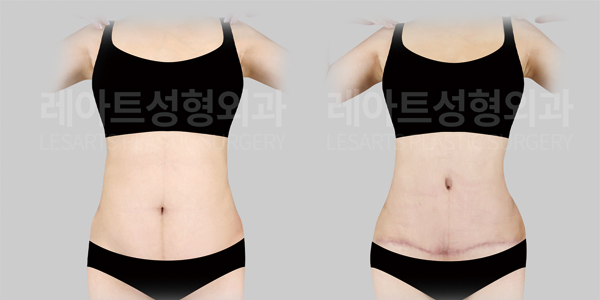Case analysis: before & after abdominoplasty revision surgery

Information
- Age : mid 40’s
- Height : 160cm
- Weight : 56kg
- BMI : 22
Surgical site
- surgical site :abdominoplasty, M-type, Triple lock, Navel Correction, abdomen liposuction
- liposuction aspirate volume : 1600cc
Abdominoplasty is a procedure designed to remove excess skin and tighten the separated rectus muscles. While the visible skin lifting is a significant part of the surgery, the correction of underlying tissues is just as crucial for achieving optimal results.
Since abdominoplasty involves extensive skin dissection and multiple-layer suturing, achieving a high level of surgical precision requires a deep understanding of both anatomical and aesthetic principles. A meticulous approach is essential to enhance the overall outcome and patient satisfaction.
If the surgical plan is inadequate or the procedure is undercorrected, the patient may be left with residual skin laxity and suboptimal improvement, while still having a visible scar.
Conversely, overcorrection can lead to excessive tension at the incision site, potentially resulting in a widened scar or an unnatural contour.
For this reason, the initial surgical plan must accurately predict the extent of correction needed while proactively preventing factors that may lead to revision surgery.
A well-thought-out surgical approach minimizes the risk of complications and ensures long-term patient satisfaction.
Below, we will review a case of abdominoplasty revision surgery performed at our clinic, detailing the preoperative concerns and postoperative improvements.

This patient had previously undergone a cesarean section many years ago and had been struggling with loose abdominal skin and excess fat accumulation for an extended period.
To address these concerns, she underwent a mini abdominoplasty and abdominal liposuction at another clinic. However, the results were not satisfactory, and she did not experience significant improvement.
One of the main issues was that the mini abdominoplasty had failed to properly correct the upper abdominal rectus muscles. As a result, her abdominal contour remained protruded above the navel, creating an uneven shape. A revision surgery was necessary to reinforce the rectus muscle repair in the upper abdomen.
Additionally, she had developed a seroma after her previous mini abdominoplasty, which had hardened into a capsule and caused adhesions in the surrounding tissue. This resulted in discomfort and further aesthetic concerns.
Due to the presence of scar tissue and the need for extensive correction, her revision abdominoplasty was expected to require a longer-than-average recovery period.

A preoperative body analysis of the patient revealed that despite undergoing a mini abdominoplasty in the past, residual skin laxity remained.
Additionally, her upper abdominal rectus muscles had not been properly corrected, leading to persistent abdominal wall looseness. The accumulation of fat in the lower abdomen further contributed to a less defined waistline, making her overall silhouette appear less contoured.
To address these concerns, a combination of a medium-type abdominoplasty and abdominal liposuction was recommended.
During the revision surgery, a new incision was planned slightly below the existing abdominoplasty scar to eliminate the old scar while ensuring an improved outcome.
The surgical approach involved extensive dissection up to the upper abdomen, allowing for proper rectus muscle tightening and reinforcement of the abdominal wall.
Additionally, as the excess skin was pulled down and removed, the navel’s shape and position would be revised to enhance overall body proportions. A detailed explanation was provided regarding this aspect of the procedure.
Since the patient had a history of keloid-prone skin and was susceptible to pigmentation, she was advised to monitor for any raised scars or unusual sensations at the incision site postoperatively. In such cases, timely follow-up visits for scar management and treatment were strongly recommended.
Below, we will analyze the patient’s preoperative and three-month postoperative medical images for a more detailed discussion.

When comparing the patient’s preoperative and three-month postoperative photos, we can observe the presence of sagging abdominal skin lacking elasticity and the outward bulging effect caused by the loosened rectus muscles extending from the upper abdomen.
To correct this, the surgical approach involved extensive dissection up to the upper abdomen, allowing for firm reinforcement of the separated rectus muscles. Additionally, excess skin was lifted and tightened, resulting in a smoother and flatter abdominal contour.
The navel was repositioned in alignment with the waistline, creating a more streamlined appearance. This adjustment not only enhanced the overall body proportions but also contributed to the visual effect of longer-looking legs.

As previously mentioned, the patient had a significant amount of abdominal fat, which contributed to the appearance of increased sagging and a less defined contour.
By performing liposuction alongside the abdominoplasty revision, we were able to refine the abdominal profile, transforming the previously protruding and uneven midsection into a flatter and more slender shape.
Since this was a revision procedure, we anticipated that the lower abdominal swelling would persist longer than it did after the initial surgery.
However, as more time passes and the swelling continues to subside, we expect the waistline to become even more sculpted and refined.

When bending forward before surgery, the patient’s abdominal skin sagged and wrinkled due to a lack of firmness. However, after the revision abdominoplasty, the abdomen now appears much firmer and more supported.
As previously mentioned, the patient has keloid-prone skin and is susceptible to hyperpigmentation. To aid in proper recovery, we provided guidance on a scar management plan, including scheduled laser treatments and injections as needed.
We also emphasized the importance of consistent self-care, including the use of scar creams and silicone bands at appropriate healing stages, to minimize scarring from the revision surgery.
With diligent care and follow-up treatments, the scar is expected to stabilize and eventually fade into a fine, subtle line.
Additionally, since the patient is now at the 3.5-month mark post-surgery, we strongly recommended maintaining proper body care through a healthy diet and regular exercise to sustain the surgical results.